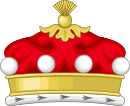Lord Torphichen

Lord Torphichen or Baron Torphichen[1] (pronounced tˈoː͡ɹfɪkən) is a title in the Peerage of Scotland. It was created by Queen Mary in 1564 for Sir James Sandilands (to whom she was related).[2][3][4]
The title stands as a rare exception to the typical rule that peerages cannot be transferred and must be inherited.[5] It is the only peerage title that might be alienated from the bloodline, enabling it to be transferred or passed on to heirs who are not direct descendants. However, its legal status remains unclear, as it has not yet been examined or adjudicated by the courts.
As of 2017[update], the title is held by the 15th Lord, who succeeded his father in 1975. He is Chief of Clan Sandilands and also holds the title of Baron of Calder, granted in 1386.[4]
The family seat is Calder House, near Mid Calder, West Lothian.
History
[edit]Sir James Sandilands had served as Preceptor to the Knights Hospitaller in Scotland. On 24 January 1564, he received a charter from Queen Mary that erected his military benefice into a temporal lordship,[4] with remainder to his heirs and assigns whatsoever, after he resigned the entire Torphichen Preceptory in West Lothian to the Crown.[6] This marks him as the inaugural Lord Torphichen.
The newly established lordship encompassed several baronies, including Torphichen, Liston, Balintrode, Tankerton, Denny, Marycoulter, Stenhope, Galtna, and others. These lands were situated across various shires, such as Edinburgh, Peebles, Linlithgow, Stirling, Lanark, and Kincardine, among others.[7] The lordship was officially designated as the Barony and Lordship of Torphichen, complete with the dignities and privileges associated with being a Lord of Parliament.[4]
Following him, all subsequent lords were descendants of the second Lord Torphichen. Notably, the second Lord's great-grandson, who became the seventh Lord, was a fervent advocate for the union with England. His lineage continued to play a significant role in Scottish politics, with his grandson, the ninth Lord, and great-great-grandson, the twelfth Lord, both serving as Scottish representative peers in the House of Lords.[8]
Barony of Calder
[edit]The first Lord was succeeded by his great-nephew, James Sandilands, who held the title of Baron of Calder, making James Sandilands the second Lord. Following this succession, the Lordship of Parliament of Torphichen was officially conjoined with the Barony of Calder, and both titles were descended down the line.
Lords Torphichen (1564)
[edit]- James Sandilands, 1st Lord Torphichen (c. 1511–1579), succeeded by his elder brother's grandson[4]
- James Sandilands, 2nd Lord Torphichen (c. 1574–1617)
- James Sandilands, 3rd Lord Torphichen (c. 1597–1622)
- John Sandilands, 4th Lord Torphichen (c. 1598–1637), brother of third Lord[4]
- John Sandilands, 5th Lord Torphichen (1625–1649), died unmarried[4]
- Walter Sandilands, 6th Lord Torphichen (1629–1696), brother of fifth Lord, m. Anne Elphinstone, daughter of Alexander, 6th Lord Elphinstone[4]
- James Sandilands, 7th Lord Torphichen (d. 1753), married Lady Jean Hume, daughter of Patrick, Earl of Marchmont[4]
- Walter Sandilands, 8th Lord Torphichen (1707–1765)
- James Sandilands, 9th Lord Torphichen (1759–1815)
- James Sandilands, 10th Lord Torphichen (1770–1862)
- Robert Sandilands, 11th Lord Torphichen (1807– 24 December 1869), nephew of 10th Lord Torphichen[9]
- James Walter Sandilands, 12th Lord Torphichen (1846–1915)[10]
- John Gordon Sandilands, 13th Lord Torphichen (1886–1973)
- James Bruce Sandilands, 14th Lord Torphichen (1917–1975)[11]
- James Andrew Douglas Sandilands, 15th Lord Torphichen (b. 1946)
The heir presumptive is the present holder's first cousin twice removed Robert Powell Sandilands (b. 1950).
The heir presumptive's heir apparent is his only son Ashton Powell Sandilands (b. 1979).
Arms
[edit]  |
|
See also
[edit]References
[edit]- ^ "No. 23622". The London Gazette. 7 June 1870. p. 2876.
- ^ Lodge, Edmund, The Genealogy of the Existing British Peerage and Baronetage, Oxford University, 1869, P. 541
- ^ Debrett's Peerage at Internet Archive.
- ^ a b c d e f g h i j Douglas, Robert. The Peerage of Scotland: Containing an historical and genealogical account of the nobility of that kingdom. pp. 669–672. Retrieved 29 August 2016.
- ^ Stevenson, John Horne (1897). Dignities. Vol. 4. pp. 226–227.
- ^ "NAS Catalogue - catalogue record". catalogue.nrscotland.gov.uk. Retrieved 28 August 2024.
- ^ "NAS Catalogue - catalogue record". catalogue.nrscotland.gov.uk. Retrieved 28 August 2024.
- ^ Balfour Paul, James (1911). The Scots Peerage. pp. 378–398. Retrieved 29 August 2016.
- ^ "Death of Lord Torphichen". The Times. 27 December 1869. p. 6.
- ^ "Death of Lord Torphichen". The Times. 21 July 1915. p. 8.
- ^ "Lord Torphichen". The Times. 15 July 1975. p. 16.

